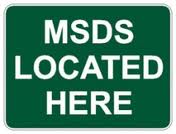 |
| A section of an MSDS sheet, showing some of the required sections. |
MSDS sheets are regularly available on the internet and many companies offer ones for their own products. For example, the Clorox company offers them for its suite of products. As an example, I'm going to break down the sheet for their Regular Bleach.
- Section I gives the name and brand of the chemical, as well as important contact information in case of accidents. Though the description of the product is here, this is more often placed in the section on physical data.
- Section II gives all potential hazards the product has. In this case, the only one is that bleach is corrosive. What follows are first aid instructions for various types of exposure.
- Section III lists all of the ingredients in the products that are potentially hazardous, their concentrations, and safe level of exposure.
- Section IV gives any safety precautions that should be taken while handling the substance, such as the wearing of gloves and goggles or ensuring proper ventilation.
- Section V lists safe containment of the materiel and is most important for products that may eat through certain types of containers.
- Section VI describes how to go about cleaning up disposal of the product, as well as cleaning up spills. This is most important for materials that are dangerous to flush into the city sewer system due to certain properties of the material itself, such as its reactivity.
- Section VII lists how the substance will react when combined with other substances. This is quite important for bleach as mixing it with a number of different materials, including ammonia, will result in toxic gasses being produced. Chlorine gas, for example, which is produced when mixing bleach and ammonia, can be extremely dangerous.
- Section VIII has all information pertaining to flammability and explosiveness. In this case, there are no dangers of exposing this substance to an open flame.
- Section IX gives all physical data for the compound, which is especially important when it is being used in experimentation. This includes the pH of the substance, as well as its boiling point, water solubility, and specific gravity (aka density). This data can be used for calculations pertaining to expected results and other such data. Other information that may be in this section include melting point, odor, color, physical state, molecular formula, and a number of other important physical properties.
There are a number of resources had large databases of MSDS sheets. Some are freely accessible, while others may require you to sign up to access the sheets. Here are some databases:
- National MSDS Repository
- 3E Company MSDS Solutions Center
- MSDS X-change
- SIRI MSDS Index
- Imperial Supplies MSDS Sheets
- Walmart Chemical Safety Right-to-Know Information Station
- Where to find MSDS on the Internet
Images are from Wikimedia Commons and are copyright free or under Creative Commons licensing: one, two.


No comments:
Post a Comment